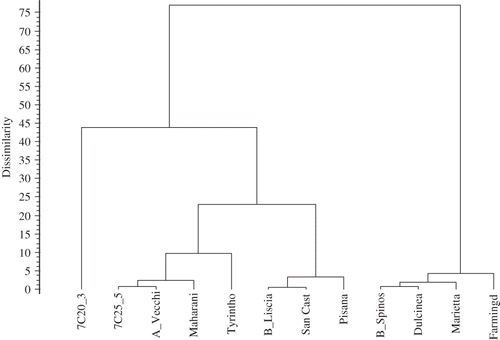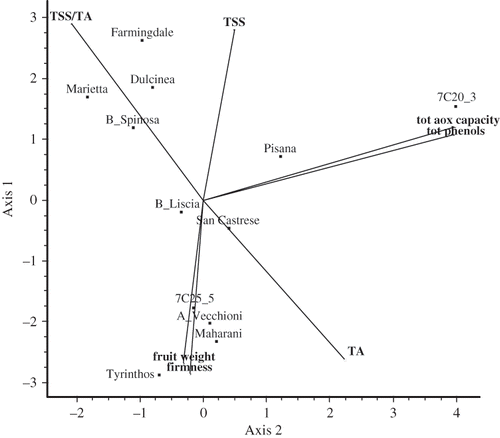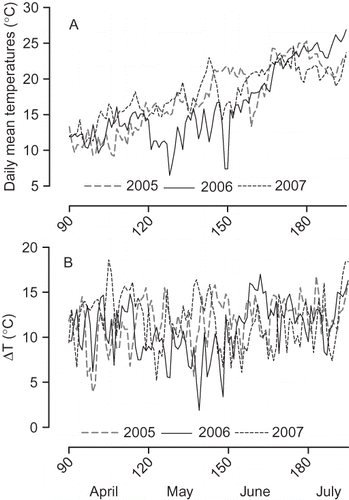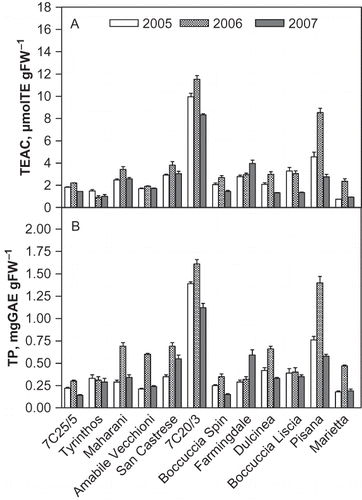Abstract
The total antioxidant capacity, total phenols, and selected pomological traits of fresh apricots belonging to 12 genotypes were investigated over a 3-year period. These analyses were carried out on apricots at the ready-to-eat stage and after 7 and 14 days at 4°C cold storage. Total antioxidant capacity and total phenols ranged from 1.14 ± 0.10 μmolTE gFW−1 to 9.93 ± 0.73 μmolTE gFW−1 and from 0.22 ± 0.01 mgGAE gFW−1 to 1.37 ± 0.11 mgGAE gFW−1, respectively. An effect of the harvest year on the antioxidant properties was also found to be dependent on the cultivars. The most storage-susceptible parameter was the flesh firmness of fruits, while the antioxidant level was maintained during storage. The influence of the genotype on fruit quality, which involves pomological and nutraceutical properties, was highlighted by analysis of variance, hierarchical clustering, and principal component analysis.
INTRODUCTION
Apricot cultivation in the Mediterranean basin is based mostly on local genotypes; each country being represented by a local germplasm in relation to several inputs that link consumer's preferences, market-oriented strategies, and health-related benefits.[Citation1–3] Given the wide variability of P. armeniaca germplasm, the potential exists to obtain an ideal cultivar by gathering all the commercial, horticultural, and quality traits in a single genotype.Citation[1,Citation4] Until now, the breeding programs have mainly focused on fruit quality improvement through the following goals: (a) high organoleptic and commercial characteristics, (b) expansion of the ripening calendar by constitution of late ripening cultivars, (c) development of new cultivars with environmental adaptability and high yield in all growing areas, and (d) promotion of resistance to diseases.Citation[3]
The concept of apricot fruit quality involves either pomological or organoleptic traits, such as size, firmness, sugar, and acid content, and levels of aromatic compounds. In addition, evolution of ripening, resistance to handling, and some aesthetic aspects, such as colour (skin and pulp), internal browning, and adhesion to the pit, represent further factors of quality that increase the commercial value of the apricot fruit.Citation[4] The effect of the environmental conditions and storage treatments, besides the genotype effect, in achieving the best fruit quality attributes can also influence fruit qualitative traits.[Citation5–7] However, for apricot species, studies combining environmental conditions, storage treatments, and nutraceutical properties of fruit are still scarce. Recently, some authors have analysed several phenolic compounds highly concentrated in the fruit, such as chlorogenic acid, neochlorogenic acid, rutin, and epicatechin, but other phenolic compounds are also present.Citation[5,Citation8,Citation9] Actually, new additional qualitative traits, which include the antioxidant properties of fruits as well as leaves or seeds,Citation[10,Citation11] are required for innovative marketing strategies. The nutraceutical profiling of apricot fruit species is still under study,[Citation12–16] with the aim to propose apricots as a ‘healthy and easy-to-eat’ fruit. Given the recent increase in the interest of consumers on the health benefits of fruit due to their antioxidant profiles, a screening among several national and international cultivars may enlarge genotype profiling for fruit quality through specific breeding programs that focus on the antioxidant levels of fruit. In this contest, hierarchical clustering and principal component analysis have been widely applied on different fruit species to differentiate cultivars on the basis of their physico-chemical traits.[Citation17–21] The principal aim of this work was to characterize several national and international apricot cultivars under classical pomological aspects and nutraceutical profiles by means of the total antioxidant capacity and phenol content. Apricot quality after cold storage was also tested in order to find out suitable cultivars for different market-oriented strategies.
MATERIALS AND METHODS
Plant Material and Experimental Procedure
Over three harvesting seasons (2005–2007), fruits belonging to 12 apricot genotypes, 10 cultivars, and 2 advanced selections were collected at physiological maturity (ready-to-eat-stage) from mid-June to mid-July. Genotypes studied herein differed on ripening time, pomological traits, and geographical origin (), according to Guerriero et al.Citation[22,Citation23] and Pellegrino et al. Citation[24] Trees (10 years old) grown in an experimental field of the Department “Coltivazione e Difesa delle Specie Legnose ‘G. Scaramuzzi’” (Pisa-University, lat. 43.02 N, long. 10.36 E), were planted in a block design, grafted on Myrobolan 29/C rootstock, and trained to a free palmette system (4 m × 4.5 m) with rows facing east-west. The orchard management was typical of standard commercial practices for weed control and fertilisation. From post-blooming to fruit harvest time, the main climatic parameters were provided by the Regional Agro-meteorological Service of Florence (ARSIA, ‘Agenzia Regionale per lo Sviluppo e l'Innovazione nel settore Agricolo Forestale’ Tuscany, Italy). Apricot fruit quality was assessed at physiological maturity after 7 and 14 days at 4 ± 0.5°C cold storage and 90% relative humidity. Samples of 30 fruits per cultivar at harvest time and after storage were randomly collected to determine the main physical-chemical parameters, total antioxidant capacity, and total phenol content.
Table 1 Geographical origin, ripening season, fruit size, and taste characteristics of 12 apricot cultivars
Physical and Chemical Determinations
From each fruit (N = 30), measurements of fresh weight, peel and flesh colour, pulp firmness, total soluble solids (TSS), and titratable acidity (TA) were determined. The skin colour of the un-blushed side, ranging from yellow to orange with all shades in between, was evaluated using a colour chart for apricot fruit created by the ‘Centre technique interprofessionnel des fruits et legumes’, CTIFL, France.Citation[25] This chart provides the evolution of the un-blushed skin colour according to 10 shades of growing intensity from 1 (green) to 10 (red-orange) through different categories (1-4: yellow-green; 5-8: yellow-orange; 9-10 red-orange). The skin colour of the blushed side ranges from pink to red. The area of the blushes was evaluated visually by classifying the red area according to the following classes: <35% (class 1), 35–65% (class 2), >65% (class 3). Firmness was evaluated with a manual penetrometer (Model 53200SP TR, TR-Turoni & C. Inc Forlì, Italy) on two peeled opposite sides at the equatorial region of the apricot, using an 11-mm-wide plunger. TSS were measured using a refractometer (Model 53015C TR, TR-Turoni & C. Inc Forlì, Italy) and expressed in °Brix at room temperature. TA was determined in fruit juice by titrating a known volume of juice with 0.1 N sodium hydroxide (NaOH) to an end point of neutral pH (8.1). TA was expressed as milliequivalents per 100 grams of fresh weight.
Total Antioxidant Capacity (TAC) and Total Phenols (TP) Analysis
These analyses were made on the same fruits that had been previously subjected to the physical and chemical determinations. Samples of 3 g of fresh material were homogenized using an ultra-Turrax T25 (Ika, Staufen, Germany) at 4°C to avoid oxidation, for three independent extractions, which were performed in 80% ethanol for 1 h in a shaker in the dark and subsequently centrifuged at 2600g for 10 min at 2–4°C.
TAC assay
Total antioxidant capacity was evaluated using the improved Trolox Equivalent Antioxidant Capacity (TEAC) method.Citation[26] The TEAC value was calculated in relation to the reactivity of Trolox, a water-soluble vitamin E analogue, which was used as an antioxidant standard. In the assay, 40 μl of the diluted samples, controls, or blanks were added to 1960 μl ABTS•+ solution, which resulted in a 20–80% inhibition of the absorbance. The decrease in absorbance at 734 nm was recorded at 6 min after an initial mixing, and plotted against a dose-response curve calculated for Trolox (0–30 μM). Antioxidant activity was expressed as micromoles of Trolox equivalents per gram of fresh fruit weight (μmolTE grFW−1). Trolox was purchased from Sigma Chemical Co. (St. Louis, MO, USA)
TP assay
Total phenolic content was determined according to the improved Folin-Ciocalteu (F-C) method.Citation[27] The assay provides a rapid and useful indication of the antioxidant status of the studied material and has been widely applied to different food samples. Gallic acid (GA; Sigma Chemical Co., St. Louis, MO, USA) was used as a standard compound for the calibration curve. Total phenol content was calculated as milligrams of GA equivalent (GAE) per gram of fresh fruit weight (mgGAE gFW−1). The absorbance of the blue coloured solutions was read at 765 nm after incubation for 2 h at room temperature.
Statistical Analysis
Data were reported as means of three independent determinations and standard errors of the means (SEM). Analysis of variance (ANOVA), Pearson's correlation, hierarchical classification (HC), and principal component analysis (PCA) were performed using the statistical package Statistica (StatSoft, Tulsa, OK, USA). Differences between means from ANOVA were considered statistically significant at P ≤ 0.05 according to the Newman-Keuls test. In the HC analysis, the distances between pairs of samples were compared on the basis of the squared Euclidean distance. The resulting clusters were connected using Ward's method, which links the two clusters for which the total sum-of-square error is smallest. PCA was applied to standardised variables. The principal components (PC) scores were plotted for individual observations in relation to the most significant axes whose eigenvalues were greater than 1.0.
RESULTS AND DISCUSSION
Pomological Properties and Antioxidant Attributes of Fruit at the Ready-to-Eat Stage
The harvest period (reported as days from ‘San Castrese’ harvesting, reference cultivar for the Italian apricot ripening calendar) and the main pomological traits, such as fruit fresh weight, skin colour of the blushed (sc-b) and un-blushed (sc-ub) areas, flesh firmness, total soluble solids, titratable acidity, and TSS/TA ratio, referred to the mean of three consecutive harvest seasons, are reported in . Among the tested cultivars, fruit size by weight was small (<45 g) only in the ‘Farmingdale’ and 7C20/3 selections, while ‘Boccuccia Spinosa’, ‘Dulcinea’, and ‘Marietta’ resulted in medium-sized, and the other seven genotypes (fruit weight >65 g) were high-sized. ‘Farmingdale’ showed the lowest flesh firmness (1.55 ± 0.12 kg/0.5 cm2) at harvest and ‘Tyrinthos’ the highest one (3.83 ± 0.19 kg/0.5 cm2). Soluble sugars, with the exception of ‘Tyrinthos’, which showed the lowest TSS content (8.15 ± 0.60°Brix), were highly concentrated (TSS content > 15°Brix) in several medium-ripening cultivars whose fruits also showed a low acidity. ‘Dulcinea’ was the sweetest cultivar, followed by ‘Boccuccia Spinosa’, 7C20/3, ‘Pisana’, and ‘Marietta’. The TSS/TA ratio was around 0.50–0.60 in the early and early-medium ripening cultivars, while higher TSS/TA values were observed in the medium-late ripening genotypes that exhibited a more balanced flavour due to an increased TSS content and a lower acidity.Citation[28]
Table 2 Harvest period (days before and after ‘San Castrese’ harvesting), peel and flesh colour, and main pomological traits in apricot fruit of 12 cultivars (fruit weight; skin colour of the blushed side [sc-b]; skin colour of the un-blushed side [sc-ub]; firmness; total soluble sugars [TSS]; titratable acidity [TA]). Means of a 3-year period ± SEM
The total antioxidant capacity ranged from 1.14 ± 0.10 μmolTE gFW−1 (‘Tyrinthos’) to 9.93 ± 0.73 μmolTE gFW−1 (sel. 7C20/3). The (ANOVA) results indicated as significant the cultivar's effect on the antioxidant properties (). Four main groups were identified: 2 of the 12 cultivars (‘Tyrinthos’ and ‘Marietta’) had the lowest TAC values, followed by a group (‘Amabile Vecchioni’, 7C25/5 selection, ‘Boccuccia Spinosa’, ‘Dulcinea’, ‘Boccuccia Liscia’, and ‘Maharani’) whose TAC was between 1.78 and 2.82 μmolTE gFW−1. ‘Farmingdale’ and ‘San Casterese’ showed a TAC value of nearly 3.25 μmolTE gFW−1, while ‘Pisana’ and 7C20/3 selection had the highest values (TAC > 4 μmolTE gFW−1). In particular, ‘Pisana’ had a TAC value 1.6-fold higher than ‘San Castrese’ and 4.5-fold higher than ‘Tyrinthos’, and 7C 20/3 value was 3-fold higher than ‘San Castrese’ and 8.7-fold higher than ‘Tyrinthos’. Total phenol content, similar to TAC, showed a significant variability related to the genotype in fully mature fruits, and values ranged from 0.22 ± 0.01 mgGAE gFW−1 (sel 7C 25/5) to 1.37 ± 0.11 mgGAE gFW−1 (sel 7C 20/3) (). A wide range of variation was also reported among several Spanish apricot varieties.[9] ‘Pisana’ contained 1.8-fold the amount of phenols than ‘San Castrese’, similar to TAC, and 4-fold the amount of 7C 25/5, which had the lowest TP value (). The selection 7C20/3 demonstrated a 2.7-fold higher TP content than ‘San Castrese’, similar to TAC results, and 6-fold higher than the amount in 7C25/5.
Table 3 Apricots at ready-to-eat stage: total antioxidant capacity (TAC) and total phenols (TP) over a 3-year period in 12 genotypes. Mean ± SEM
In order to show a possible relation between ripening time of the studied cultivars and total antioxidant capacity, regression analysis was carried out. A weak relationship was shown () despite a positive trend being found. Two genotypes, late ripening ‘Marietta’ with low TAC and medium ripening 7C20/3 with very high TAC, were excluded from this analysis. Actually, we are still involved in TAC-screening among other genotypes, which differ for ripening calendars in order to enrich and confirm these results.
Figure 1 Linear regression between total antioxidant capacity and harvest time of the studied cultivars. Harvest time was reported as days (−18 to +10) before and after ‘San Castrese’ (SC) harvesting.

Pearson's correlation among different pomological and chemical variables was performed to find possible relations between antioxidant properties and pomological traits in apricot fruit. The resulting coefficients were summarized in . Considering the results over a 3-year period, a weak negative correlation was found between fruit weight and chemical parameters, such as sugar content (r = −0.406), total antioxidant capacity (r = −0.363), and total phenols (r = −0.330), which were affected in a percentage of variation of about 10–17% by apricot fruit weight. The most significant part of the total antioxidants and total phenols variability is likely to be ascribed to the genetic traits of each cultivar. Positive correlation coefficient was found between TAC and TP (r = 0.97, P < .001), which may suggest a significant contribution of polyphenols to the total antioxidant capacity. Similar results were reported in peaches,[16] plums,Citation[29,Citation30] small fruits,Citation[31] and apricots.[13] Negative correlation was found between flesh firmness and total soluble sugars (r = −0.773, P < .01) and between TSS/TA ratio and TA (r = −0.923), so firmer fruits tend to show lower sugar content and more acid apricots show a lower value of TSS/TA.
Table 4 Pearson's coefficients among antioxidant properties (TAC and TP), fruit weight (FW), flesh firmness, total soluble sugars (TSS), and sugars/acids ratio (TSS/TA) for the studied cultivars over a three-year period. Bold coefficients are significant at P ≤ .05
In order to differentiate cultivars according to the pomological and nutraceutical properties (fruit weight, flesh firmness, TSS, TA and TSS/TA ratio, TAC, and TP), cluster analysis (HC) and principal component analysis (PCA) were performed. A dendrogram resulting from cluster analysis was reported in , which showed four different clusters. Cluster 1 contained 7C20/3 selection only; cluster 2: 7C25/5, ‘Amabile Vecchioni’, ‘Maharani’, and ‘Tyrinthos’; cluster 3: ‘Boccuccia Liscia’, ‘San Castrese’, and ‘Pisana’; and cluster 4: ‘Boccuccia Spinosa’, ‘Dulcinea’, ‘Marietta’, and ‘Farmingdale’. 7C20/3 selection (cluster1) differentiated from the other genotypes for a small size and very high antioxidant level. Cluster 2 was represented by fruit size very large (64–100 g), high TA and low TSS content, TSS/TA around 0.5–0.6, and low antioxidant level. In cluster 3, genotypes showed large size (65–68 g), lower TA compared to cluster 2, TSS/TA around 0.7–1.1, and medium-high antioxidant potential. Cluster 4 showed fruits whose weight was around 50–60 g, TSS/TA around 1.5–2.2, and low-medium antioxidant level. Cultivar characterization by PCA indicated two principal components, which accounted for about 82% of the total variance. The variables highly correlated to PC1 accounted for pomological traits, which included fruit weight, firmness, TSS, TA, and TSS/TA ratio, while the ones correlated to PC2 were responsible for the antioxidant properties of fruit: TAC and TP. The PCs scores were plotted for individual observations in relation to PC1-PC2 () and the component loadings for the studied variables were reported in . Similar groups to the ones shown by cluster analysis were observed. The first PC axis, representing 50% of the variability, opposed cultivars that had higher fruit weight, firmness, and acidity to those with higher TSS and TSS/TA ratio. In addition, PC1 mainly discriminated early and early-medium ripening genotypes from the medium and medium-late ripening ones. The second principal component accounted for 32% of the total variability and mainly differentiated ‘Pisana’ and selection 7C20/3 from the other cultivars for their high and very high antioxidant properties, respectively.
Table 5 Component loadings for antioxidant TAC and TP variables and selected pomological variables of apricots (fresh weight, flesh firmness, total soluble solids, TSS, titratable acidity, TA, and TSS/TA ratio). Bold numbers are loadings >.7000
Harvest Year
From April to July over a 3-year period (2005–2007), climatic data, in particular mean temperatures, the maximum-minimum temperature fluctuations, and the cumulative amount of rainfall, were recorded for each harvest season. In 2006, during May, the lowest mean temperatures with the smallest max-min temperature fluctuations occurred; however, starting from June 2006, higher mean temperatures, high fluctuations around mid-June, and mostly dry conditions were registered in correspondence of the final stages of fruit growth ( and and ). The higher TAC and mostly TP values, obtained during 2006, can likely be related either to the lowest cumulative amount of rainfall over May–June (77.6 mm), especially during June (0.4 mm) to harvest (), or to the high mean temperatures registered during late June/half July. In 2006, ‘Pisana’ had the highest increase of TAC and TP (); other genotypes, such as ‘San Castrese’, 7C 20/3, and ‘Dulcinea’, showed a similar trend with higher antioxidant levels in 2006, despite the increase being lower compared to ‘Pisana’ cultivar.
Table 6 Cumulative monthly rainfall (mm) from April to mid-July over a 3-year period (2005–2007)
The ANOVA results comparing harvest year and cultivar effect showed significant interactions ‘genotype x year’ for TAC and TP properties (). In recent years, the deficit irrigation effect on apricot fruit, mandarin fruit, and virgin olive oil qualityCitation[5,Citation32,Citation33] has been investigated involving pomological properties as well as phenolic composition and volatile compounds.
Table 7 Three-way ANOVA results. Variables: TAC (μmolTE gFW−1) and TP (mgGAE gFW−1)
Cold Storage
In relation to the susceptibility of apricot fruit to handling, storage, and transport, pomological and chemical performances among different cultivars were tested after 7 and 14 days at 4°C cold storage (as indicated for apricot fruit). During storage, fruit-weight loss was around 2–6% over 14 days, with the highest decrease after 7 days. For the selection 7C20/3, the weight loss (15%) was particularly evident over the second week of storage (data not shown). The most storage-susceptible parameter was flesh firmness () and half of the cultivars showed a loss of firmness after 14 days, though not below 2 kg/0.5 cm2. In some cases, firmness decreased soon after 7 days of storage. ‘Maharani’, ‘San Castrese’, and ‘Dulcinea’ were able to maintain flesh firmness even after 2 weeks of storage. ‘Farmingdale’ reached the lowest flesh firmness value (nearly 1 kg/0.5 cm2) after 1 week. The total soluble sugars and titratable acidity were not significantly affected by the storage conditions (data not shown) as previously reported.[15] Similar results, which reported a loss of firmness after storage in the apricot cultivar ‘Bergeron’ without changes on TSS and TA levels, have been recently published.Citation[34] Overall, total antioxidant capacity and total phenols were maintained during storage (, ). The increase in TAC and TP of about 30% in 7C20/3 apricots stored for 14 days was partially explained by a weight loss of 15% after 14 days of storage for this genotype. Di Vaio et al.Citation[35] reported an increase of the total antioxidant capacity and total phenols level in 1 week cold-stored peaches in relation to the cultivar.
Figure 6 Flesh firmness of 12 apricot cultivars at the ready-to-eat-stage (M) and after 7 (M+7d) and 14 (M+14d) days at +4°C cold storage. Mean ± SEM.
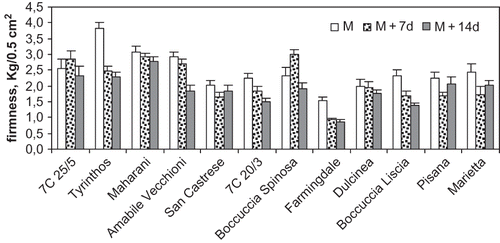
Figure 7 Total antioxidant capacity (TAC, a) and total phenols (TP, b) in 12 apricot genotypes at the ready-to-eat stage (M) and after 7 (M+7d) and 14 (M+14d) days at 4°C cold storage. Mean ± SEM.
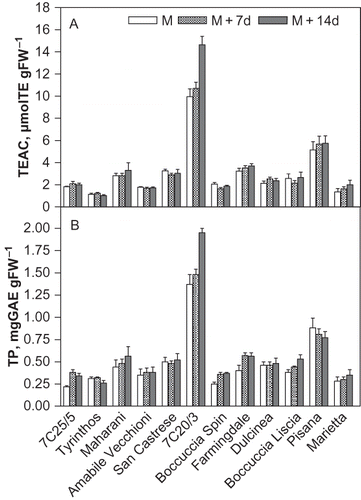
The analysis of variance was carried out considering three main effects (genotype, year, and cold storage) on the antioxidant properties of fruits. ANOVA results indicated as significant the interaction ‘genotype × year × storage’ () for TAC and TP variables. In particular, 7C 20/3 selection and ‘Pisana’ had outstanding antioxidant properties, which reached higher levels in 2006, even after 2 weeks of storage. The interaction ‘genotype × storage × cultivation system organic/integrated’ for TAC and TP has been previously reported in apricot fruit.[15] For the genotypes studied herein, the antioxidant properties of fruit were also influenced by the harvest season, in terms of environmental conditions.
CONCLUSIONS
Cluster analysis and principal component analysis clearly differentiated early/early-medium ripening cultivars from the medium/late ones on the basis of their pomological characteristics. An effect of the genotype on the antioxidant properties and a high variability of these traits among cultivars were also found. In our study, the nutraceutical fruit-profiling might represent a tool to innovate marketing strategies of valuable genotypes for fresh consumption and it can likely be of great use to create parental lines with high levels of antioxidants for future breeding programs. Promising genotypes, which showed high antioxidant capacity and excellent pomological properties, may be indicated in ‘Pisana’ and 7C20/3 selections. The well known ‘San Castrese’ fruits, despite a major use as processed apricots, showed unchanged pomological and biochemical properties during storage. The healthy attributes when coupled with the pomological quality might increase both consumer's satisfaction and producer's interest. In relation to the harvest season and storage treatment, ANOVA results showed that the antioxidant potential of apricot fruit is also related to the environmental conditions and can be influenced by the interaction among genotype, year, and storage. Fruit storability and the stability of the antioxidants can likely be considered for future studies on quality improvement of apricot species in which climatic conditions (high temperatures and drought during fruit growth) may play a role in the antioxidants fruit content. A linear inverse relationship between the water status and total phenol content was found in olive oil[33] and an increase in antioxidants activity and total phenols in mandarin fruit under deficit irrigation was reported.[32] Flesh firmness still remains the fruit trait most affected by storage conditions in apricots; however, some genotypes studied herein were able to maintain firmness values around 2 kg/0.5 cm2 after 2 weeks of cold storage despite the unavoidable loss of pulp consistency. In conclusion, although the quality of each cultivar is related to its growing environment in terms of climatic conditions and agricultural practices, the influence of the genotype on the qualitative fruit profile regarding both the physico-chemical and nutraceutical fruit properties is significant and should be stressed.
ACKNOWLEDGMENTS
The authors wish to express their gratitude to the Bank Fundation ‘Cassa dei Risparmi di Livorno’ (Italy) that financially contributed to the results obtained in this work. Thanks to Daniel de Bettencourt (Asheville, NC, USA) for the English revision and his helpful comments.
REFERENCES
- Audergon , J.M. , Giard , A. , Lambert , P. , Blanc , A. , Gilles , F. , Signoret , V. , Richard , J.C. , Albagnac , G. , Bureau , S. , Gouble , B. , Grotte , M. , Reich , M. , Legave , J.M. , Clauzel , G. , Dicenta , F. , Scortichini , M. , Simeone , A.M. , Guerriero , R. , Viti , R. , Monteleone , P. , Bartolini , S. , Martins , J.M.S. , Tsiantos , J. and Psallidas , P. 2006 . Optimization of apricot breeding by a joint conventional and molecular approach applied to the main agronomic traits—ABRIGEN Project . Acta Horticulturae , 701 : 317 – 320 .
- Bassi , D. and Pirazzoli , C. 1998 . The stone fruit industry in the Mediterranean region: Agronomic and commercial overview . Options Méditerranéennes , 19 ( B ) : 3 – 38 .
- Guerriero , R. , Monteleone , P. and Iacona , C. 2006 . Apricot breeding in Pisa: Some new selections for Italian growers . Acta Horticulturae , 701 : 341 – 346 .
- Bassi , D. and Audergon , J.M. 2006 . Apricot breeding: Update and perspectives . Acta Horticulturae , 701 : 279 – 294 .
- Dragovic-Uzelac , V. , Levaj , B. , Mrkic , V. , Bursac , D. and Boras , M. 2007 . The content of polyphenols and carotenoids in three apricot cultivars depending on the stage of maturity and geographical origin . Food Chemistry , 102 : 966 – 975 .
- Munzuroglu , O. , Karatas , F. and Geckil , H. 2003 . The vitamin and selenium contents of apricot fruit of different varieties cultivated in different geographical regions . Food Chemistry , 83 : 205 – 212 .
- Pérez-Pastor , A. , Ruiz-Sanchez , M.C. , Martinez , J.A. , Nortes , P.A. , Artes , F. and Domingo , R. 2007 . Effect of deficit irrigation on apricot fruit at harvest and during storage . Journal of the Science of Food and Agriculture , 87 : 2409 – 2415 .
- Robards , K. , Prenzler , P.D. , Tucker , G. , Swatsitang , P. and Glover , W. 1999 . Phenolic compounds and their role in oxidative processes in fruits . Food Chemistry , 66 : 401 – 436 .
- Ruiz , D. , Egea , J. , Gil , M.I. and Tomas-Barberan , F.A. 2005 . Characterization and quantitation of phenolic compounds in new apricot (Prunus armeniaca L.) varieties . Journal of Agricultural and Food Chemistry , 53 : 9544 – 9552 .
- Roy , L.G. , Arabshahi-Delouee , S. and Urooj , A. 2010 . Antioxidant efficacy of Mulberry (Morus indica L.) leaves extract and powder in edible oil . International Journal of Food Properties , 13 : 1 – 9 .
- Mandic , A.I. , Dilas , S.M. , Cetkovic , G.S. , Canadanovic-Brunet , J.M. and Tumbas , V.T. 2008 . Polyphenolic composition and antioxidant activities of grape seed extract . International Journal of Food Properties , 11 : 713 – 726 .
- Bartolini , S. , Viti , R. and Zanol , G.C. 2006 . Apricot cultivars and cold storage affect total antioxidant capacity and glutathione content in fruit . Acta Horticutlurae , 717 : 359 – 362 .
- Guclu , K.G. , Altun , M. , Ozyurek , M. , Karademir , S.E. and Apak , R. 2006 . Antioxidant capacity of fresh, sun- and sulphited-dried Malatya apricot (Prunus armeniaca) assayed by CUPRAC, ABTS/TEAC and Folin methods . International Journal of Food Science and Technology , 41 : 76 – 85 .
- Leccese , A. , Bartolini , S. and Viti , R. 2008 . Total antioxidant capacity and phenolics content in fresh apricots . Acta Alimemtaria , 37 : 65 – 76 .
- Leccese , A. , Bureau , S. , Reich , M. , Renard , M.G.C. , Audergon , J.M. , Mennone , C. , Bartolini , S. and Viti , R. 2010 . Pomological and nutraceutical properties in apricot fruit: Cultivation systems and cold storage fruit management . Plant Food for Human Nutrition , 65 : 112 – 120 .
- Scalzo , J. , Politi , A. , Pellegrini , N. , Mezzetti , B. and Battino , M. 2005 . Plant genotype affects total antioxidant capacity and phenolic contents in fruit . Nutrition , 21 : 207 – 213 .
- Aubert , C. and Chanforan , C. 2007 . Postharvest changes in physicochemical properties and volatile constituents of apricot (Prunus armeniaca L.) characterization of 28 cultivars . Journal of Agricultural and Food Chemistry , 55 : 3074 – 3082 .
- Cantin , C.M. , Gogorcena , Y. and Moreno , M.A. 2010 . Phenotypic diversity and relationships of fruit quality traits in peach and nectarine [Prunus persica (L.) Batsch] breeding progenies . Euphytica , 171 : 221 – 226 .
- Nikolic , D. , Rakonjac , V. , Milatovic , D. and Fotiric , M. 2010 . Multivariate analysis of vineyard peach [Prunus persica (L.) Batsch.] germplasm collection . Euphytica , 171 : 227 – 234 .
- Ruiz , D. and Egea , J. 2008 . Phenotypic diversity and relationship of fruit quality traits in apricot (Prunus armeniaca L.) germplasm . Euphytica , 163 : 143 – 158 .
- Silva , B.M. , Andrade , P.B. , Martins , R.C. , Valentao , P. , Ferreres , F. , Seabra , R.M. and Ferreira , M.A. 2005 . Quince (Cydonia oblonga Miller) fruit characterization using principal component analysis . Journal of Agricultural and Food Chemistry , 53 : 111 – 122 .
- Guerriero , R. , Iacona , C. , Monteleone , P. , Viti , R. and Gentili , M. 2005 . Cinque nuove cultivar di albicocco diffuse dall'Università di Pisa (Five new apricot cultivars selected by Pisa University) . Frutticoltura , 6 : 24 – 27 .
- Guerriero , R. , Iacona , C. , Pellegrino , S. , Berra , L. , Pennone , F. , Mennone , C. , Mezzetti , B. , Murri , G. , Bassi , D. , Rizzo , M. and Pirazzini , P. 2006 . Albicocco . [Apricot] L'Informatore Agrario , 23 : 6 – 10 .
- Pellegrino , S. , Capocasa , F. , Pennone , C. and Guerriero , R. 2004 . Liste varietali dei fruttiferi. [Varietal lists of fruit species.] . L'Informatore Agrario , 24 : 9 – 13 .
- Lichou , J. , Jay , M. , Vaysse , P. and Lespinasse , N. 2003 . Reconnaître les Varietes d'Abricots. [Recognizing apricot varieties.] , 17 – 29 . Paris , , France : Ctifl .
- Arts , M.J.T.J. , Dallinga , J.S. , Voss , H.P. , Haenen , G.R.M.M. and Bast , A. 2004 . A new approach to assess the total antioxidant capacity using the TEAC assay . Food Chemistry , 88 : 567 – 570 .
- Waterhouse , A.L. 2001 . “ Determination of total phenolics ” . In Current Protocols in Food Analytical Chemistry , Edited by: Wroslad , R.E. I1.1.1 – I1.1.8 . New York : John Wiley & Sons Inc .
- Bassi , D. and Selli , R. 1990 . Evaluation of fruit quality in peach and apricot . Advances in Horticultural Science , 2 : 107 – 111 .
- Kim , D. , Jeong , S.W. and Lee , C.Y. 2003 . Antioxidant capacity of phenolic phytochemicals from various cultivars of plums . Food Chemistry , 81 : 321 – 326 .
- Diaz-Mula , H.M. , Zapata , P.J. , Guillen , F. , Castillo , S. , Martinez-Romero , D. , Valero , D. and Serrano , M. 2008 . Changes in physicochemical and nutritive parameters and bioactive compounds during development and on-tree ripening of eight plum cultivars: A comparative study . Journal of the Science of Food and Agriculture , 88 : 2499 – 2507 .
- Castrejón , A.D.R. , Eichholz , I. , Rohn , S. , Kroh , L.W. and Huyskens-Keil , S. 2008 . Phenolic profile and antioxidant activity of highbush blueberry (Vaccinium corymbosum L.) during fruit maturation and ripening . Food Chemistry , 109 : 564 – 572 .
- Navarro , J.M. , Pérez-Pérez , J.G. , Romero , P. and Botia , P. 2010 . Analysis of the changes in qualità in mandarin fruit, produced by deficit irrigation treatments . Food Chemistry , 119 : 1591 – 1596 .
- Servili , M. , Esposto , S. , Lodolini , E. , Selvaggini , R. , Taticchi , A. , Urbani , S. , Montedoro , G. , Serravalle , M. and Gucci , R. 2007 . Irrigation effects on quality, phenolic composition and selected volatiles of virgin olive oils cv. Leccino . Journal of Agricultural and Food Chemistry , 55 : 6609 – 6618 .
- Aubert , C. , Bony , P. , Chalot , G. and Hero , V. 2010 . Changes in physicochemical characteristics and volatile compounds of apricot (Prunus armeniaca L. cv. Bergeron) during storage and post-harvest maturation . Food Chemistry , 119 : 1386 – 1398 .
- Di Vaio , C. , Graziani , G. , Marra , L. , Cascone , A. and Ritieni , A. 2008 . Antioxidant capacities, carotenoids and polyphenols evaluation of fresh and refrigerated peach and nectarine cultivars from Italy . European Food Research and Technology , 227 : 1225 – 1231 .
